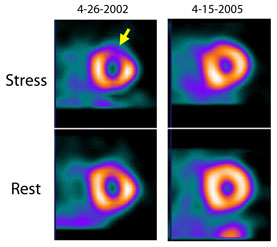A brave new world of consumer gene tests
Direct-to-consumer tests are easy, cheap—and sometimes wrong. Yet, patients are handing them to their doctors on a weekly basis and asking for advice. Learn how to work with patients after they've sought out genome-wide analysis and then bring the results to doctors to sort out subtle meanings from often fallible tests.
Time magazine dubbed it The Invention of the Year for 2008. The New York Times wrote a whimsical article about it that stayed on the “most e-mailed” list of stories for weeks. And experts at the American Heart Association's Scientific Sessions conference last November couldn't stop talking about its implications.
Direct-to-consumer genetic testing is a hot ticket these days, with a buzz that's stoked by a continual stream of studies on breaking genetic news. The tests, which range from $399 to $2,500, claim to enlighten consumers about various illnesses that loom in their future or diseases they might escape. Some of them even tell whether you're likely to go bald.

The problem is that the tests don't always work. Cardiologist Eric Topol, FACP, who is director of the Scripps Translational Science Institute and chief academic officer of Scripps Health in La Jolla, Calif., volunteered early on to be a guinea pig for a company that offers the scans. A fit individual with no family history of cardiac disease, he was assigned a heart attack risk of 101%.
“I called my wife and jokingly told her I might not be coming home that evening, because apparently I was a walking heart attack. Then I called the company and told them there must be a mistake because it's a little hard to go higher than a 100% risk,” Dr. Topol said. (The company soon corrected his risk to 54%.)
Unlike Dr. Topol, consumers and some physicians are often unaware of the nascent nature of these tests, or the fact that the results aren't deterministic. This needs to change, because the tests are becoming increasingly popular, experts said.
“I hear anecdotal reports on a weekly basis about people approaching health care professionals with results from these tests, asking for help,” said W. Gregory Feero, MD, PhD, head of the Genomics Healthcare Branch at the National Human Genome Research Institute in Washington, D.C., and a genomics columnist for ACP Internist. “Health care providers definitely can't ignore this, and should begin to understand what the tests can and can't tell you, because (the tests) will eventually play a role in providing preventive services.”
Limits of genome-wide tests
Unlike tests that aim to give specific genetic information, such as whether a woman with breast cancer will respond to tamixofen, the consumer genetic tests are genome-wide scans that provide information on dozens of diseases and traits. They do this by examining portions of genes called “SNPs” (Single Nucleotide Polymorphisms), which can serve as disease markers.
The tests are fallible, in part, because they offer risk estimates about conditions that may be influenced by dozens of genes, but for which not all the genetic markers are known. If, for example, one were to add up the markers for diabetes that have been discovered to date, they would total about 20. Yet these 20 predict only 5%-10% of the total heritable risk for developing type 2 diabetes, Dr. Feero said.
“The information we do know the 5%-10% of the risk in the case of diabetes is reasonable in terms of scientific validity,” Dr. Feero said. “But it only predicts a small percentage of total risk, so people might over-interpret its usefulness.”
Unlike conditions such as Huntington's Disease, which a person will definitely get if she has a simple genetic mutation and lives long enough, complex conditions like heart disease are usually affected by many genes. And some are more important than others, said Kelly Ormond, program director for Stanford University's Master's Program in Human Genetics and Genetic Counseling, and a consultant for consumer genetic testing company Navigenics.
“For common medical conditions, I imagine genes as rocks in a glass. Some are really big rocks, and some are really little. And if you get to a certain point, that glass is going to fill up and push you over the threshold for the condition. Maybe you have two big genes that bring you to the threshold; maybe it's 10 smaller ones,” Ms. Ormond said. “And maybe it also takes environmental impacts on top of those genes to cause you to develop a condition.”
Another caveat is that the genetic research coming out now mostly comprises “association studies,” whereby the genes of people with a condition like heart disease are compared to those without it, and differences are observed. That's a far cry from being able to declare those genetic differences causal, Ms. Ormond said.
“If I test five genes on a person with heart disease, and she has a combination—some with a polymorphism associated with increased risk and some without, how does that add up? Are the effects additive? Multiplicative? How do I create the formula? In most cases, we don't really know the answer, and some believe it is premature to offer this sort of information to consumers if we don't know what it fully means,” Ms. Ormond said. “Others say it's your genetic information, so why should we stop you from getting it?”
As well, most of the genetic discoveries so far have been in homogenous populations, largely of European descent. Genetic risks may well differ among ethnic groups, Dr. Feero said.
How to talk to patients
A main goal for primary care providers is to explain to patients who inquire about genetic tests that the results aren't conclusive, for all the reasons discussed above, experts said.
“I think the greatest misconception on the part of patients is that, if you have the tests done and they show you are high risk for the disease, then you will get the disease,” Dr. Feero said. “The other one is that if you don't show a high risk, then you won't get the disease. So there is a danger that a person's test may come back negative for that 5% of diabetes risk we can actually predict, and he thinks he is in the clear and can eat whatever he wants.”
Indeed, this potential for misunderstanding is part of the reason that most experts are reluctant to recommend patients get the tests done at all. Taking a comprehensive family history is actually a superior way to determine risk, albeit not as sexy, they said.
“Family history is much better at predicting a larger portion of your inherited risk than the currently known genetic markers for any disease that I am aware of except, perhaps, macular degeneration,” Dr. Feero said. “So if a patient came in with $1,000 to spend, I'd advise using it on a gym membership, not a consumer genetic test.”
Still, for patients who independently decide to get a genome-wide scan, providers can offer a little background on the main companies that offer them, Dr. Topol said. Navigenics has options for $2,499 and $499. The former gives information on 28 conditions and the latter 10, and both offer phone access to a genetic counselor. deCODEme's Complete Scan costs $985, and analyzes risk factors for 39 traits and conditions. Both Navigenics and deCODEme “try to use only the hardest evidence,” Dr. Topol said meaning the data come from multiple and replicating studies with tens of thousands of people.
23andMe is the cheapest test at $399, and includes more of what Dr. Topol calls “recreational information,” such as whether one is disposed to have hard or soft ear wax. All told, it gives feedback on a whopping 114 traits and diseases.
“23andMe is a little more for fun. It does include some serious medical conditions, but the proof or evidence doesn't appear to be quite as rigorous,” Dr. Topol said. “It makes for good cocktail party chatter.”
Sometimes patients walk into their providers' offices with test results already in hand, Dr. Feero noted. In these cases, the provider should still explain the limits of the test's usefulness to the patient. At the same time, the physician can use the encounter as a chance to suggest lifestyle changes to someone who, for example, not only shows a possible genetic risk of heart attack, but has high blood pressure and exercises infrequently.
“The test gives you an advantage in terms of where you can start putting some of your priorities,” Dr. Topol said. “Primary care providers can help in that regard by saying, for example, ‘Your risk of colon cancer appears to be increased. Let's do a screening test for this.’”
Internists may also want to recommend that patients inform family members if they get a test finding that suggests high risk of a heritable disease, Ms. Ormond said.
Some patients may want more information on their genetic test results than a primary care provider is able to give. As such, it would be wise for internists to have a list of clinical geneticists or genetic counselors in their city, region or state for referrals, Ms. Ormond said. Doctors can also go to the Web sites of the National Society of Genetic Counselors or the American Society of Human Genetics to find specialists.
The future of genetic tests
Most experts believe genetic tests will increase in popularity over the next decade, as more and more genetic discoveries are made, and as the price of testing declines. Eventually, the tests should have real clinical benefit to patients and providers, Dr. Feero said.
“At some point in time, we will cross a threshold where we really do have enough information to make useful predictions based on these types of genetic tests. It will probably not come in a flood, but there will be one, then two … then four and five … and someday there will be 50 different diseases that we have useful information for,” Dr. Feero said.
This may, in turn, tax the resources of the roughly 5,000 genetic counselors and geneticists in the U.S., making it even more important that physicians be able to discuss test results with patients.
“What has become a trickle (of interest) is about to become a firehose,” noted Hank Greely, JD, a Stanford law professor who specializes in biomedical issues, at the AHA conference. “It's an ethical imperative that we find better ways to inform patients of what these test results mean.”





